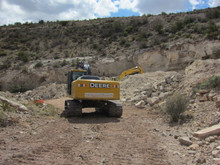Mining in Arizona has always been very important.
Over 900 different minerals have been discovered in Arizona. Hundreds of towns in Arizona owe their very existence to mining operations. Arizona’s economy, growth, and infrastructure is largely due to mining operations. Popular tourist destinations in Arizona are old mining towns. The world’s largest gem and mineral show takes place annually in Tucson, Arizona. Copper mining in Arizona has been a major industry since the 19th century. In 2007 Arizona was the leading copper-producing state in the U.S. Copper is actually one of the five C’s in Arizona’s slogan, these five elements (Cooper, Cattle, Cotton, Citrus, Climate) are considered critical to the economy of the state of Arizona. Arizona’s nickname is “The Copper State”. And copper is even incorporated into the Arizona state flag; the copper star in the center signifies the importance of copper mining in the state.
Arizona became a state on February 14, 1912. It covers 113,998 square miles and it is currently ranked as the sixth largest state. About 25% of the state is Native American reservations, about 15% is privately owned and the rest is public lands: BLM, forest and parks, and state trust land. More than 400,000 mining claims have been filed in Arizona, some big-some small, some successful-some disasters.
In ancient history Native Americans occupied areas that now lie within the state of Arizona. The people mostly did surface digging for salt, pigment materials, stones, and turquoise and used them for tools, weapons and adornments. Two pieces of turquoise jewelry, the oldest found in the U.S., were discovered near current day Casa Grande, and are believed to date from between 200 BC to 300 AD. A large salt mine near Camp Verde was hand dug between 900 to 1200 AD.
The first mineral explorations began in the 1500’s when Spanish explorers came looking for riches. Silver was discovered near Verde Valley, but it appeared to have been dug on by the Native Americans earlier. The first gold was discovered in 1604 near Santa Maria. In 1736 a deposit of Native Silver was discovered a short distance from what is now known as Nogales, Sonora, Mexico. The site was known as “Arizonac”, “Arissona”, and “Aruzema”, and is probably the origin of Arizona’s name.
In 1848, in the treaty settlement of the Mexican-American war, the U.S. paid Mexico $15,000,000 for a large area that encompassed parts of Northern Arizona, as well as California, Nevada, Utah, and parts of New Mexico, Colorado and Wyoming. In 1854 the Gadsden Purchase was an agreement between the United States and Mexico, in which the United States agreed to pay Mexico $10 million for a 29,670 square mile portion of Mexico that later became parts of southern Arizona and southern New Mexico. This purchase gave the U.S. the largest silver producing area in the state, later to become Tombstone, and the large copper districts that included several areas including Ajo and the famous Bisbee area.
After the Civil War, the federal government sought to bring a higher population into the Western frontier. The Homestead Act of 1862 was designed to entice people to come out and hunt for minerals. That was enhanced by the 1872 Mining Law which allowed, under most conditions, free access to mineral prospecting on public lands. During the 19th century mining claims were easy to file and land was cheap.
After the California gold fields were played out, the prospectors made their way to Arizona. Wickenburg was founded because of the nearby location of gold that became known as the Vulture Mine. The best known silver rush was the in the middle of the 1870s when people rushed to the silver bonanzas of Tombstone in southeast Arizona. By the 1880s, with the need for copper wiring, copper became more valuable and copper production eclipsed the precious metals. This brought about large copper mines and towns, such as Bisbee and Jerome. Today there are virtually no gold or silver mines in Arizona, though stories of lost gold mines still enchant people!
In 1912, when Arizona became a state, there were 445 active mines, including 51 gold mines. The office of the State Mine Inspector was created to establish and enforce mine safety rules. Unfortunately Copper prices crashed during the depression in the 1930’s, causing most of Arizona’s copper mines to reduce production or cease operating. The three that still operated were the Copper Queen in Bisbee, the Magma in Superior, and the Little Daisy in Jerome.
Despite the mine closings and the subsequent loss in population as miners sought work elsewhere, the Arizona state legislature continued to recognize the importance of mining to the economy and they created the Arizona Bureau of Mines in 1915, to research and collect data, and the Arizona Department of Mineral Resources in 1939, to assist small miners, and mining explorations. With the Second World War mining again became important and in 1940 Arizona was the 14th largest producer of minerals in the U.S.
In 2019 Arizona has 454,523 mining claims on public lands managed by the Bureau of Land Management. 48,799 are considered active mines. In 2017 Arizona was the second largest producers of minerals in the U.S.
The boom and bust economy of mining also left hundreds of ghost towns across the state of Arizona. But that would be a separate story! Stay tuned!
 US Dollar
US Dollar
 Australian Dollar
Australian Dollar
 Euro
Euro
 CAD
CAD

